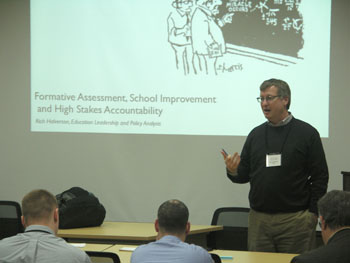WCER Hosts 2013 Conference on Engaged Research
February 21, 2013

UW Educational Leadership and Policy Analysis Associate Professor Richard Halverson
The Wisconsin Center for Education Research hosted administrators from school districts across the state at its 2013 Conference on Engaged Research on Tuesday, Feb. 19.
More than 40 members of Wisconsin’s Cooperative Educational Service Agencies (CESAs) and representatives from the Wisconsin Department of Public Instruction (DPI) convened at the University of Wisconsin-Madison’s Educational Sciences building. The conference, the 16th annual iteration of the event, seeks to share the work of University of Wisconsin education researchers with administrators from the state’s school districts.
“It’s really intended to be a partnership-building strategy in which WCER and (the university’s) Education Outreach and Partnerships are collaborating to forge relationships not only with CESAs, but also with district superintendents and representatives of DPI,” said WCER Director Adam Gamoran. “We think this group, working together, can be effective at collaborating and establishing a dialogue about what we’re learning, where there’s give and take from both sides.”
This year’s conference featured presentations on video games and learning, dropout prevention and the creation of an early warning system, leadership assessment, and standards and instruction for English language learners. Participants asked questions and WCER researchers made pitches for districts to serve in pilot programs for their various projects.
“This conference is one of the main ways we respond to the Wisconsin Idea, which is that the new knowledge we produce through research should be useful to the members of our community and the citizens of our state,” Gamoran said. “This is a chance to advance that aim.”
Becky Collins, the Regional Special Education Services Network Director for CESA #9, said her trip down from Tomahawk to attend the conference had been worth it.
“The statewide CESA organization is in such a good position to bring all this information back and share it with a wide audience very easily,” Collins said. “We can bridge the divide between the university and the state’s schools and hopefully bring some of this cutting-edge research into classrooms across Wisconsin.”


